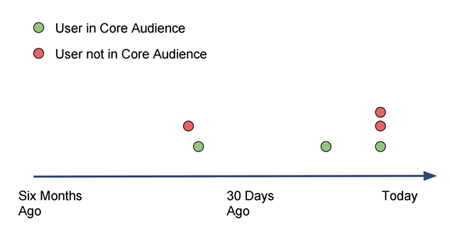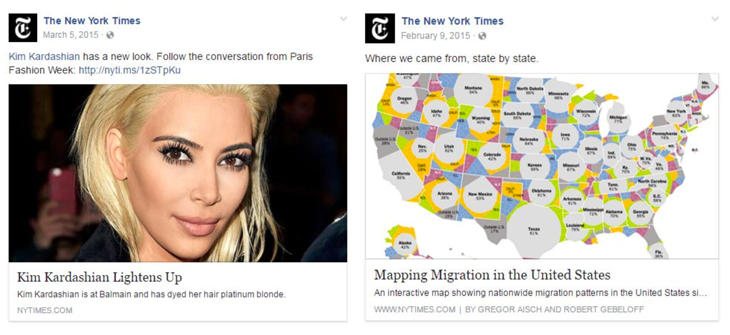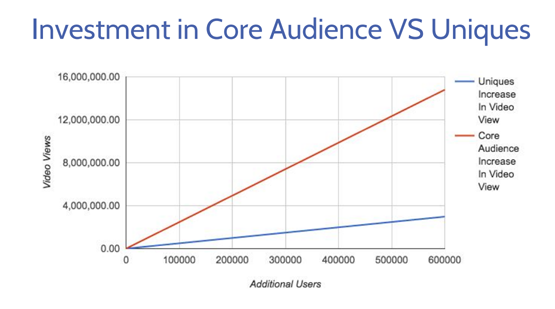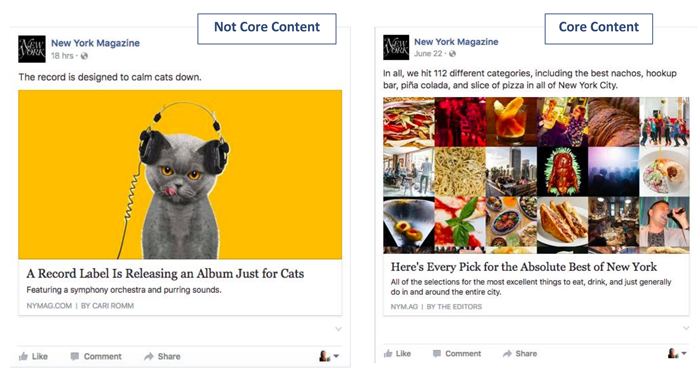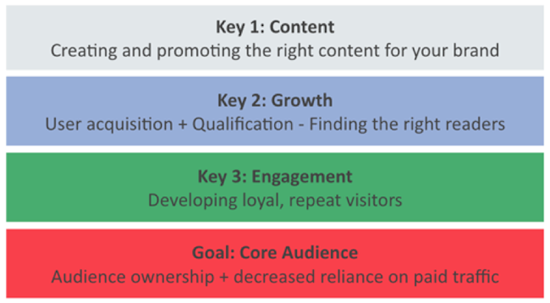In Arthurian legend, The Holy Grail is a mystical relic that offers prosperity and eternal life to whomever completes the difficult quest to find it. Like the Knights of Camelot, publishers have been on a search for their own Holy Grail — a way to guarantee the health and longevity of their businesses. Their Grail brings the promise of new revenue streams and scalable monetization methods for years to come.
For publishers, The Holy Grail is the core audience.
The Core Audience
A core audience is the segment of a publication’s readership that is most loyal to the brand; the visitors that return to a publisher’s site with a regular cadence. Establishing a core audience is essential for all publishers because it’s a prerequisite for content monetization. It’s not until they have built up a substantial core audience, one with enough critical mass, that they’re able to extract worthwhile value from their assets. Generally, the larger the core audience, the more revenue the brand can generate.
In terms of traffic, publishers benefit twofold from building a large core audience. First, publishers can monetize the organic traffic that core audience members generate. Second, the core traffic that is driven through paid advertising will have a low CPC.
Another advantage that comes with building a core audience is that it increases a publisher’s ComScore ranking, making it more appealing to brands, advertisers, and agencies. Core audiences are also prime for helping publishers meet business objectives, like email signups and e-commerce conversions, which we’ll get to a bit later.
To understand how to develop the Holy Grail of audiences, let’s begin with a slightly more technical definition of “core audience.”
For the purpose of this discussion, we’ll define “core audience” as the segment of readers who meet both of the following criteria:
- They have visited your website on at least two different days in the last 30 days
- They visited at least one time prior to the last 30 days but within the last 6 months.
For almost all publishers, the reality is that only fraction of all traffic can be attributed to core audience members. Many publishers, then, have turned to paid means to bolster their overall web traffic.
Owning vs. Renting Your Audience
Paid acquisition is a common strategy for publishers looking to create audiences for their content, leveraging display advertising to drive traffic to their sites. One can view this practice somewhat akin to audience “renting,” since the traffic brought in this way tends to be rather fleeting. These readers have no real connection with the brand, typically consuming a single piece of content before leaving the publisher’s site.
Due to the fact that publishers have to persistently cough up cash to maintain a certain level of traffic, this strategy of “renting” audiences quickly becomes costly. This is magnified by today’s siloed distribution ecosystem, which requires brands to not only pay, but to pay within each channel. Therefore, instead of being complacent with a revolving door of visitors, publishers should strive to “own” these audiences and convert them into members of their core audience.
Now that we’ve established what constitutes a core audience member and the benefits of developing this segment, let’s dig into the steps it takes to build a core audience.
Step 1: Qualify Your Audience
The first important consideration when developing a core audience is to ensure that the users who you’re attracting through paid channels are the right fit for you publication, and have the potential to become part of your core audience. The goal is to find readers that are not only interested in the content that brings them to your site, but those whose interests are likely to extend to the other areas of focus for your brand.
An effective way to approach this is to use your existing content to pre-qualify users as potential core audience members. To do this, carefully select from what you’d consider to be your “core content” — the articles with substance that speak to the type of publisher that you are fundamentally. The best choice is to choose content that is best aligned with your brand and business objectives.
This means that if you’re a hard-hitting news outlet, you’d be ill-advised to attempt growing your core audience using a celebrity gossip article. While you’ll likely drive a lot of traffic at little cost, it won’t contribute to the ultimate goal because celebrity gossip is not what keeps your loyal readers coming back. You’d be better off using, say, an in-depth analysis of a recent presidential debate.
Consider the two posts above from The New York Times. It’s is easy to see why the article titled ‘Mapping Migration in the United States’ would be a prime example of the Times’ core content. It’s the kind of in-depth analysis that people love and have come to expect from The Times — a compelling story that keeps the core audience coming back. On the other hand, while there are likely many Times readers who happen to be Kim Kardashian fans, their primary source for Kardashian family news is probably not The New York Times.
Once you have identified your core content, you’ll then incorporate it into your paid acquisition efforts. Here, the content will dictate the audiences that you’re targeting, not the other way around. The beauty of this method is that when a user clicks on an ad featuring your core content, it signals that they’re likely to enjoy your other types of content as well. They’re essentially pre-qualifying themselves as a potential member of your core audience.
Keep in mind that this first step will probably require you to pay a higher CPC to bring these visitors to your site, but core audiences have the potential to pay dividends down the road. In fact, some publishers have discovered that one core user can be up to five times more valuable than a passerby. This makes the initial investment worthwhile.
How to measure success: Success at this stage can be measured by number of email signups, which indicates that you’re targeting the right audience, and time spent on site, which can be used as a proxy to gauge the level of interest the audience has in your brand’s content.
A core user can be up to five times more valuable than a passerby
Step 2: Engage and Re-engage
At this point you’ve identified the audiences who have pre-qualified themselves as a potential core audience members. Now comes the “development” part of “audience development.”
In this next step, you’ll work on encouraging your core audience to return to your site and become habitual readers. To do this, re-target the readers on the cusp of becoming part of the core audience. A cost-effective strategy to re-engage these readers is to serve them a mixture of on-brand, higher-CPC content, along with some lightweight, clickable content that will have a lower CPC. You’ll want to continue delivering relevant content to sub-audiences within this group, optimizing for high frequency and content quality.
It’s worth noting that during this re-engagement period you can expect to pay a slightly lower CPC, since it involves promoting content with a broader appeal and that’s more “clickable” by nature.
How to measure success: You can measure success at this stage by the degree to which the CPC decreases.
Measuring Success
By this point you should start seeing the fruits of your labor as your core audience grows. In addition to the benefits associated with the previous steps, like increased time on site and email signups, here are the primary indicators of success:
- Organic traffic – You should expect to see an increase in organic traffic from the users you initially targeted with paid advertising.
- Increase in subscriptions – As these loyal readers become endeared to your brand, publishers offering subscriptions to their content should begin to see a rise in number of subscriptions, and therefore an increase in subscription revenue
- E-commerce conversions – Brands offering products through various e-commerce channels can expect an uptick in on-site conversions
These markers of success will of course depend on your individual brand and business objectives. Now that you’ve built up this powerful core audience, it’s up to you to determine how to best leverage your influence and monetize your brand’s assets.
Recap
Building up a loyal core audience isn’t easy, but it’s certainly worth it. It begins with thoughtfully choosing content that best represents your brand, your core content. This core content is then used to target audiences likely to become members of your core audience, allowing them to self-select and pre-qualify themselves as potential loyal readers. Once these users are identified, you then deliver a mixture of high and low CPC content to encourage them to re-engage. Over time these casual readers will become habitual visitors, eventually becoming part of your core audience.
It’s up to publishers to decide which avenues they want to take toward monetizing their core audience, but it’s clear that they all should pay special attention to growing this valuable subset of their readership. As The Holy Grail granted everlasting life to those who could manage to find it, a publisher’s core audience is the key to its continued success and prosperity.
Read more about email monetization here.
—
About Keywee
Keywee enables the creation, distribution and measurement of content that drives business results for publishers, retailers and brands. Hundreds of iconic brands and digital natives like The New York Times, The BBC, AOL, and Forbes use Keywee’s revolutionary platform to find the audiences most likely to meet specific goals for their content.
Interested in learning more about Keywee? Click here to request a demo.
